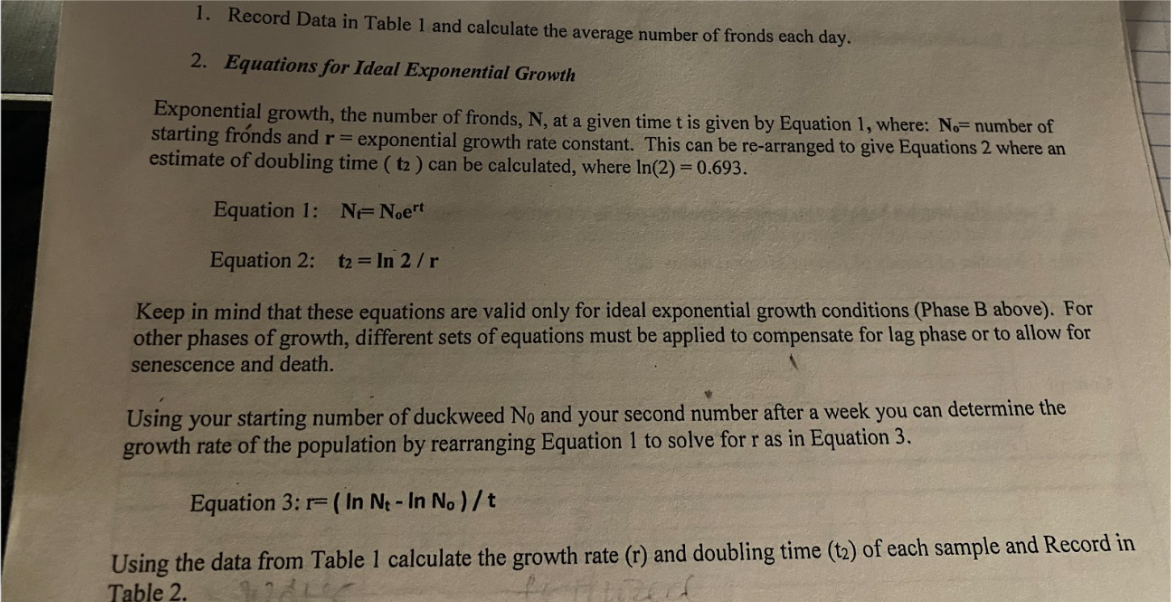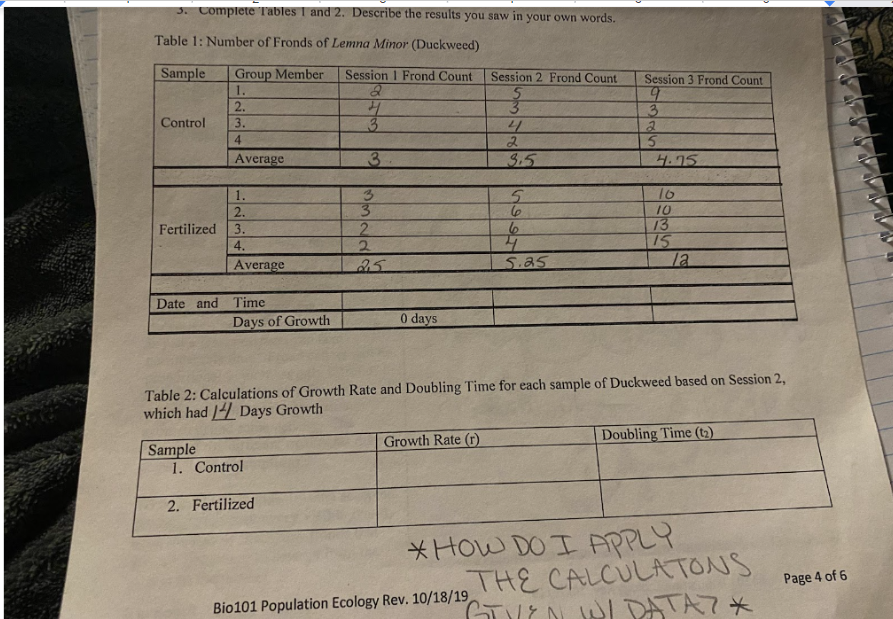Table 1: Number of Fronds of Lemna Minor (Duckweed) Sample Group Member 1. 2. Control 3. 4 Average 1. 2. Fertilized 3. 4. Average Date and Time Days of Growth Session I Frond Count Session 2 Frond Count 2 Sample 1. Control 2. Fertilized 3 3 2 2 25 0 days 4 2 3.5 5 4 5.25 Growth Rate (r) Session 3 Frond Count 9 3 2 5 4.15 10 10 13 15 Table 2: Calculations of Growth Rate and Doubling Time for each sample of Duckweed based on Session 2, which had 14 Days Growth la Doubling Time (t₂) *HOW DO I APPLY
Table 1: Number of Fronds of Lemna Minor (Duckweed) Sample Group Member 1. 2. Control 3. 4 Average 1. 2. Fertilized 3. 4. Average Date and Time Days of Growth Session I Frond Count Session 2 Frond Count 2 Sample 1. Control 2. Fertilized 3 3 2 2 25 0 days 4 2 3.5 5 4 5.25 Growth Rate (r) Session 3 Frond Count 9 3 2 5 4.15 10 10 13 15 Table 2: Calculations of Growth Rate and Doubling Time for each sample of Duckweed based on Session 2, which had 14 Days Growth la Doubling Time (t₂) *HOW DO I APPLY
Linear Algebra: A Modern Introduction
4th Edition
ISBN:9781285463247
Author:David Poole
Publisher:David Poole
Chapter6: Vector Spaces
Section6.7: Applications
Problem 14EQ
Related questions
Question
***given the calculations, how do I apply it to the data taken?***

Transcribed Image Text:1. Record Data in Table 1 and calculate the average number of fronds each day.
2. Equations for Ideal Exponential Growth
Exponential growth, the number of fronds, N, at a given time t is given by Equation 1, where: No- number of
starting fronds and r = exponential growth rate constant. This can be re-arranged to give Equations 2 where an
estimate of doubling time (t2) can be calculated, where In(2) = 0.693.
Equation 1: N- Noert
Equation 2: t2 = In 2/r
Keep in mind that these equations are valid only for ideal exponential growth conditions (Phase B above). For
other phases of growth, different sets of equations must be applied to compensate for lag phase or to allow for
senescence and death.
Using your starting number of duckweed No and your second number after a week you can determine the
growth rate of the population by rearranging Equation 1 to solve for r as in Equation 3.
Equation 3: r-(In Ne-In No) / t
Using the data from Table 1 calculate the growth rate (r) and doubling time (t2) of each sample and Record in
Table 2.

Transcribed Image Text:3. Complete Tables 1 and 2. Describe the results you saw in your own words.
Table 1: Number of Fronds of Lemna Minor (Duckweed)
Sample Group Member
1.
2.
3.
4
Average
Control
Fertilized
1.
2.
3.
4.
Average
Date and Time
Days of Growth
Session I Frond Count Session 2 Frond Count
2
Sample
1. Control
2. Fertilized
3
3
3
3
2
2
25
0 days
Growth Rate (r)
4
2
3.5
5
4
5.25
Bio101 Population Ecology Rev. 10/18/19
Session 3 Frond Count
9
3
2
5
4.15
10
Table 2: Calculations of Growth Rate and Doubling Time for each sample of Duckweed based on Session 2,
which had Days Growth
10
13
15
la
Doubling Time (t₂)
*HOW DO I APPLY
THE CALCULATONS
GIVEN W/ BATA? *
Page 4 of 6
Expert Solution
This question has been solved!
Explore an expertly crafted, step-by-step solution for a thorough understanding of key concepts.
This is a popular solution!
Trending now
This is a popular solution!
Step by step
Solved in 3 steps

Recommended textbooks for you

Linear Algebra: A Modern Introduction
Algebra
ISBN:
9781285463247
Author:
David Poole
Publisher:
Cengage Learning

Algebra & Trigonometry with Analytic Geometry
Algebra
ISBN:
9781133382119
Author:
Swokowski
Publisher:
Cengage

Algebra and Trigonometry (MindTap Course List)
Algebra
ISBN:
9781305071742
Author:
James Stewart, Lothar Redlin, Saleem Watson
Publisher:
Cengage Learning

Linear Algebra: A Modern Introduction
Algebra
ISBN:
9781285463247
Author:
David Poole
Publisher:
Cengage Learning

Algebra & Trigonometry with Analytic Geometry
Algebra
ISBN:
9781133382119
Author:
Swokowski
Publisher:
Cengage

Algebra and Trigonometry (MindTap Course List)
Algebra
ISBN:
9781305071742
Author:
James Stewart, Lothar Redlin, Saleem Watson
Publisher:
Cengage Learning

College Algebra
Algebra
ISBN:
9781305115545
Author:
James Stewart, Lothar Redlin, Saleem Watson
Publisher:
Cengage Learning
